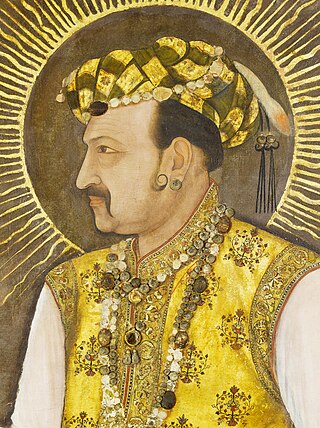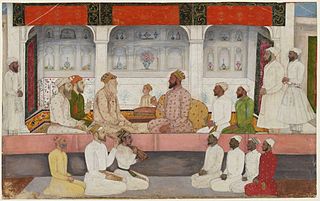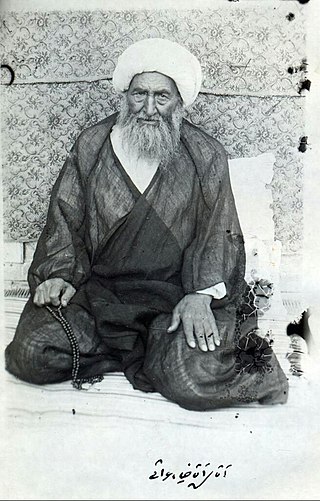
Nur-ud-Din Muhammad Salim, known by his imperial name Jahangir, was the fourth Mughal Emperor, who ruled from 1605 till his death in 1627.

Badakhshan is a historical region comprising parts of modern-day north-eastern Afghanistan, eastern Tajikistan, and Taxkorgan Tajik Autonomous County in China. Badakhshan Province is one of the 34 provinces of Afghanistan. Much of historic Badakhshan lies within Tajikistan's Gorno-Badakhshan Autonomous Region in the southeastern part of the country. The music of Badakhshan is an important part of the region's cultural heritage.

Mir Qamar-ud-din Khan Siddiqi also known as Chin Qilich Qamaruddin Khan, Nizam-ul-Mulk, Asaf Jah and Nizam I, was the first Nizam of Hyderabad. He was married to the daughter of a Syed nobleman of Gulbarga. He began his career as a favourite of the Mughal emperor Aurangzeb, who made him a general. Following the death of Aurangzeb in 1707, Asaf Jah refused to favour any one of Aurangzeb's warring sons and as such remained neutral. When Aurangzeb's third son Bahadur Shah ultimately emerged victorious, Asaf Jah was rotated as governor of multiple Mughal provinces until 1714, when he was created Viceroy of the Deccan with authority over six Mughal provinces in southern India from 1714 to 1719. From 1719 onwards he was involved in combating the intrigues of the Sayyid Brothers. From 1720 to 1722 he helped the new Mughal emperor Muhammad Shah eliminate the Sayyed brothers and was rewarded by being elevated to the grand viziership from 1722 to 1724. He also engaged in military conflict against Bajirao I in Battle of Palkhed and Battle of Bhopal.

Shahrokh Shah or Shahrokh Mirza, better known by his dynastic title of Shahrokh Shah was the Afsharid king (shah) of the western part of Khorasan from 1750 to 1796, with a two-month interruption. A grandson of the Iranian conqueror Nader Shah, Shahrokh was the son of Reza Qoli Mirza Afshar and his Safavid wife Fatemeh Soltan Begom, who was the sister of Tahmasp II, the penultimate Safavid shah of Iran. Shahrokh's half-Safavid descent made him stand out amongst his Afsharid relatives, and was used to bolster the legitimacy of his grandfather. After the assassination of Nader Shah in 1747, his nephew Ali-qoli Khan, ascended the throne in Mashhad and had all of Nader Shah's descendants in fortress of Kalat massacred. Shahrokh was spared in case his Safavid lineage would come to use, and was instead kept in the fortress as a prisoner. While Adel Shah was battling his rebellious younger brother Ebrahim Mirza, a party of Turkic, Kurdish, and Arab tribal leaders took advantage of his absence and installed Shahrokh on the throne. Both Adel Shah and Ebrahim were eventually defeated and killed, but Shahrokh was not long afterwards overthrown by a party of dissident tribal leaders, who installed the Safavid pretender Mir Sayyed Mohammad on the throne. Shahrokh was soon blinded at the instigation of Mir Alam Khan Khuzayma and other leading nobles, much against Suleiman II's will.

Mirza RajaMan Singh I was the 24th Maharaja of Amber from 1589 to 1614. He also served as the Subahdar of Bengal for three terms from 1595 to 1606 and the Subahdar of Kabul from 1585 to 1586. He served in the Imperial Mughal Army under Emperor Akbar. Man Singh fought sixty-seven important battles in Kabul, Balkh, Bukhara, Bengal and Central and Southern India. He was well versed in the battle tactics of both the Rajputs as well as the Mughals. He is commonly considered to be one of the Navaratnas, or the nine (nava) gems (ratna) of the royal court of Akbar.

The Sayyid brothers refers to Syed Hassan Ali Khan Barha and Syed Hussain Ali Khan, who were two powerful nobles during the decline of the Mughal Empire.

Raja Bharmal, also known as Bihari Mal, and Bihar Mal, was the 22nd Kachwaha Rajput ruler of Amber, which was later known as Jaipur, in the present-day Rajasthan state of India.
The Farooqi dynasty was the ruling dynasty of the Khandesh Sultanate from its inception in 1382 till its annexation by the Mughal emperor Akbar in 1601. The founder of the dynasty, Malik Ahmad participated in a rebellion against the Bahmani ruler Muhmmad Shah I in his early years. When he was compelled to flee from Deccan, he established in Thalner on the Tapti River. After receiving the grant of the fiefdoms of Thalner and Karanda from Firuz Shah Tughluq in 1370, he conquered the region around Thalner, which later became known as Khandesh. By 1382, he started ruling independently.
Mujhera is a village in the Jansath sub-division of Muzaffarnagar District in Uttar Pradesh. It is the seat of the Kundliwal branch of Sadaat-e-Bahra.

Amiral Kabir Sayyid Mahmud Khan Barha, also known as Mahmud Khan and mahmud dewaan, was a general in the Akbar's army, son of Sayyid Mubarak, was the first person of this family - the Sayyids of Barah - to rise to the rank of a nobleman. This he did through his bravery and valour during the Timurid dynasty. He joined the service of Bairam Khan.
Haji Hud (1025–1142) was a prominent Muslim saint who migrated to India and settled there for propagation of Islam.

Saif Khan was a favorite of Emperor Jahangir since he was a prince and chief of Sayyids of Barha in Jahangir's time. Jahangir writes in his memoirs in the narration of his first regnal year "Sayyed Ali Asghar Bahra who has not a rival in bravery and zeal, is son of Sayyed Mahmud Khan Barha who was a great Amir of my father. This year I have bestowed on him the title of Saif Khan and thus distinguished him in equals and pears. He has never taken any intoxicating substance in his life. He is one of those few confidants who have been with me in hunting and other places". His rank was three thousands personal and two thousand and five hundred horse.

Daniyal Mirza was the shahzada of the Mughal Empire who served as the Viceroy of the Deccan. He was the third son of Emperor Akbar and the half-brother of Emperor Jahangir.

Zia'eddin Araghi also known as Agha Zia'eddin Araghi was an eminent Shia jurist, Usuli and Mujtahid during the flourishing the Usul Fiqh in Ja'fari school in Shia after Muhammad Baqir Behbahani.
Shams-ud-Din Muzaffar Shah III was the last sultan of the Muzaffarid dynasty who nominally reigned over the Gujarat Sultanate, a late medieval kingdom in India from 1561 to 1573 though true powers were exerted by his nobles. Mughal Emperor Akbar annexed Gujarat in his empire in 1573. Muzaffar Shah III was taken prisoner to Agra. In 1583, he escaped from the prison and with the help of the nobles succeeded to regain the throne for a short period before being defeated by Akbar's general Abdul Rahim Khan-I-Khana in January 1584. He fled and finally took asylum under Jam Sataji of Nawanagar State. The Battle of Bhuchar Mori was fought between the Mughal forces led by Mirza Aziz Koka and the combined Kathiawar forces in 1591 to protect him. He finally committed suicide in 1592 when he was surrendered to the Mughal by the ruler of Cutch State.
In 1573, Mughal Emperor Akbar conquered Gujarat Sultanate taking advantage of young Gujarat Sultan Muzaffar Shah III and his quarrelling nobles. Muzaffar was held captive at Agra. He appointed his foster brother Mírza Âzíz Kokaltásh as the first viceroy who faced an insurrection by the rebel nobles of the former Sultanate. Akbar quickly came to aid and ended the insurrection. He soon appointed Mírza Khán who managed to set revenue system and quelled attack by the Mirzas with help of Mughal minister Todar Mal. The next viceroy Shaháb-ud-dín strengthened the military. Soon Sultan Muzaffar escaped, returned to Gujarat and led an attack on Ahmedabad and recaptured it before his former noble and now viceroy Itimad Khan reach the city. Soon Mirza Khan was reappointed as the viceroy who defeated Muzaffar in the battle of Fatehwadi in 1584. Soon Kokaltásh returned as the viceroy and defeated Muzaffar and combined Kathiawad forces in battle of Bhuchar Mori. Later Muzaffar was captured but he committed suicide, putting an end to the Gujarat Sultanate. As Kokaltásh went to the Mecca on pilgrimage, Sultan Murad Bakhsh was appointed as the viceroy on whose death, Kokaltásh returned third time as the viceroy. Akbar was succeeded by Jehangir.

The last two Gujarat Sultans, Ahmad Shah III and Mahmud Shah III, were raised to throne when they were young so the nobles were ruling the Sultanate. The nobles divided territories between themselves but soon started fighting between themselves for supremacy. One noble invited the Mughal emperor Akbar to intervene in 1572 which resulted in the conquest of Gujarat by 1573 and Gujarat becoming the province of the Mughal Empire.

The Barha dynasty was a Shi'a Indian Muslim dynasty that was influential in India during the era of Delhi Sultanate and Mughal Empire.

The Rajput rebellion began in 1708, due to the harsh treatment of the Rajput Rajas by the Mughal emperor. It erupted into a two-year rebellion that forced the Mughal emperor to sue for peace, give them gifts, and restore the Rajput holdings which had been annexed by the previous Mughal emperor Aurangzeb.













